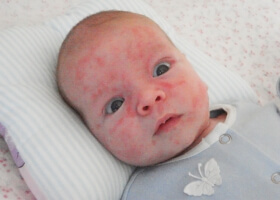Allergy to dust: symptoms and treatment
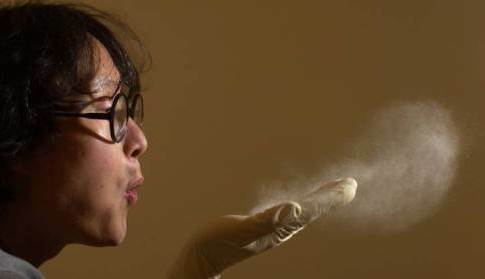 According to statistics, allergy affects about 10-30% of the total population.WHO predicts the 21st century will be the era of allergic diseases.Allergy is a superreaction of the organism that occurs in response to the action of a certain factor of the external environment( allergen).There are many allergens, contact with some of them can be minimized.But what if the allergy is caused by dust.Where to get away from it, if it surrounds us everywhere?
According to statistics, allergy affects about 10-30% of the total population.WHO predicts the 21st century will be the era of allergic diseases.Allergy is a superreaction of the organism that occurs in response to the action of a certain factor of the external environment( allergen).There are many allergens, contact with some of them can be minimized.But what if the allergy is caused by dust.Where to get away from it, if it surrounds us everywhere?
Causes of dust allergy
Dust consists of many components: mineral particles, and textile, paper fibers, epidermis of animals, insects, people, and pollen.Each of these components in itself can already act as an allergen.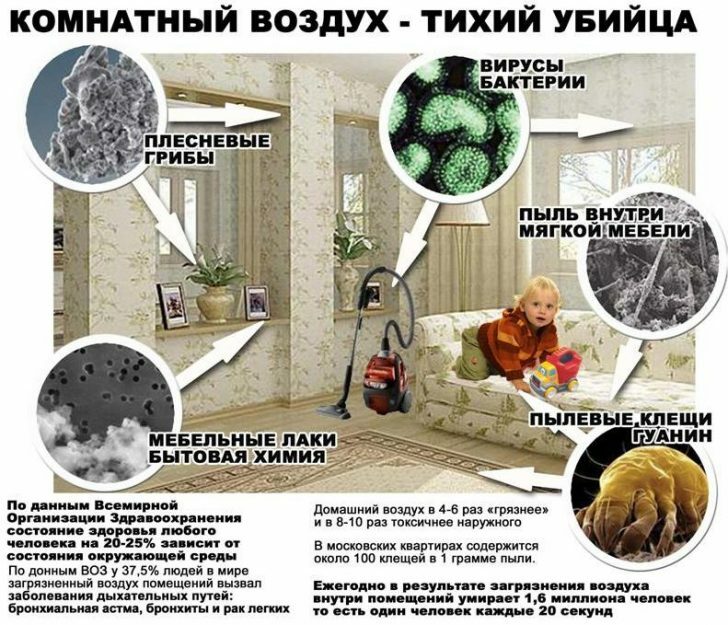
But according to modern studies, in most cases the allergic reaction develops on a dust mite of the genus Dermatophagoides.One gram of dust can contain several thousand ticks.These are small arthropods measuring 0.1-0.5 mm, which can be considered only under a microscope.They do not bite a person, are not carriers of infectious diseases, but the products of their vital activity are allergenic to humans.
Ticks most comfortable feel at a temperature of 18-25 degrees and high humidity.Therefore, arthropods live mainly in blankets, mattresses, pillows, carpets, soft upholstery.Feed on mites dead epidermal cells of man.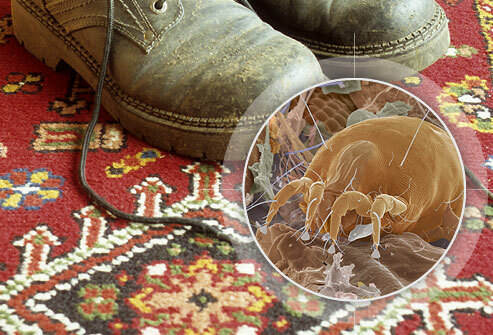
Symptoms of dust allergy
People with dust allergy notice painful symptoms of the disease throughout the year.But exacerbations are observed in the spring-autumn period.And it is not surprising, because at this time the air temperature gradually rises, reaching the figures most comfortable for the life of mites.
Dust allergies in humans can manifest themselves in different ways.It is noteworthy that if a person leaves an apartment with dust mites for a long time, his condition improves noticeably. Allergy to dust can occur in such forms:
- Allergic rhinitis;
- Allergic conjunctivitis;
- Bronchial asthma;
- Atopic dermatitis.
Allergic rhinitis
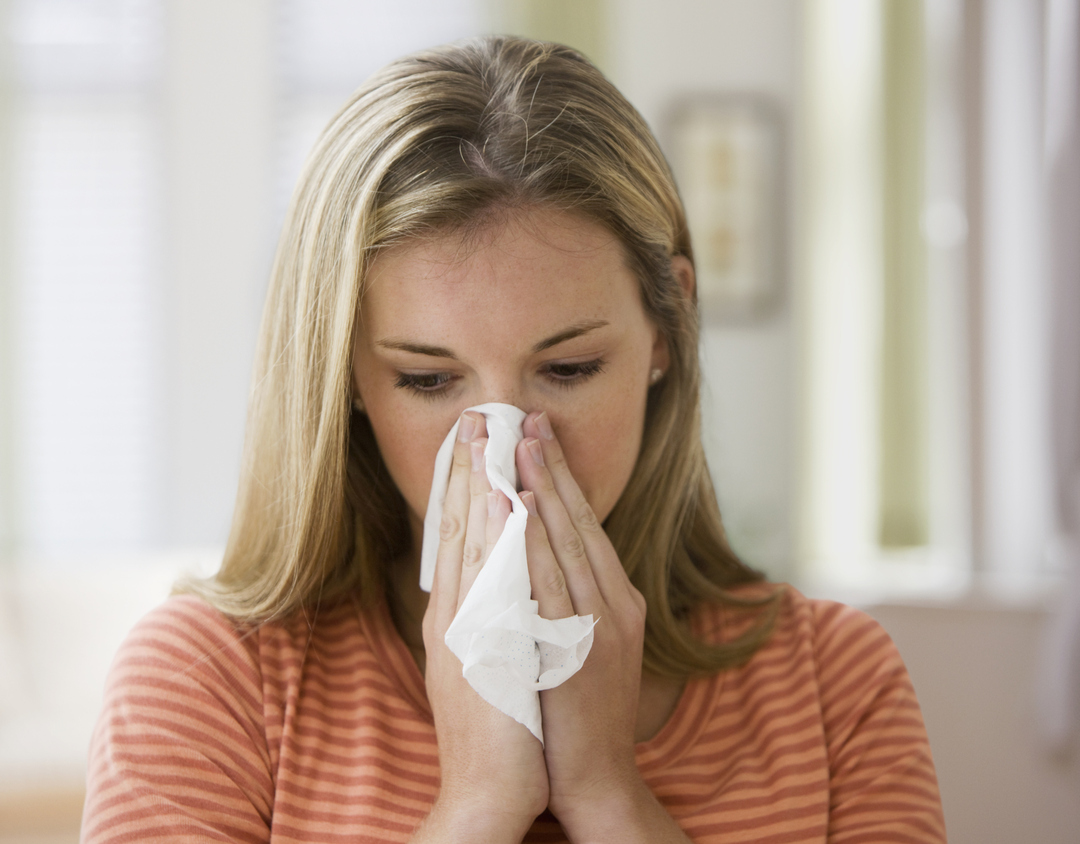 Rhinitis begins with the appearance of itchy sensations in the nose, accompanied by sneezing.Then the person marks the appearance of mucous, transparent, abundant discharge from the nose.Runny nose can greatly impede the breathing of a person.A disturbed breathing can cause a headache.In addition, a person may be bothered by itching, perspiration in the nasopharynx.
Rhinitis begins with the appearance of itchy sensations in the nose, accompanied by sneezing.Then the person marks the appearance of mucous, transparent, abundant discharge from the nose.Runny nose can greatly impede the breathing of a person.A disturbed breathing can cause a headache.In addition, a person may be bothered by itching, perspiration in the nasopharynx.
Allergic conjunctivitis
With this form of a person's allergy, burning sensation in the eyes is troubled, which is why he constantly rubs his eyelids.There are eyelid swelling, redness of the conjunctiva, lachrymation.Sometimes sight can deteriorate: the surrounding objects seem to the person blurred.Especially difficult is conjunctivitis in people who use contact lenses.
Asthma
It is believed that approximately 70% of people with bronchial asthma have seizures caused by inhalation of dust.When the allergen enters the respiratory tract, there is a spasm of the respiratory muscles, as well as an excessive production of gullet secretions by the goblet cells.All this leads to the appearance of choking, the person suffocates and coughs.The patient begins to panic, rush about the apartment.The attack of suffocation can end fatal if medical help is not provided on time.
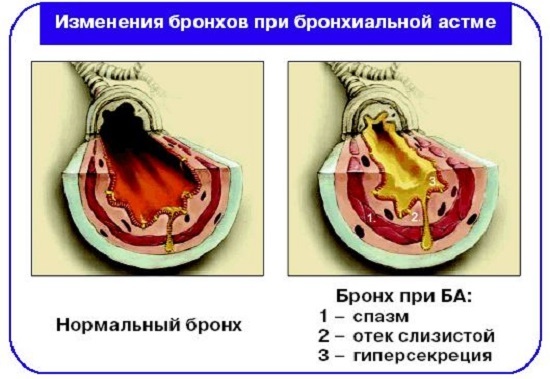
Atopic dermatitis
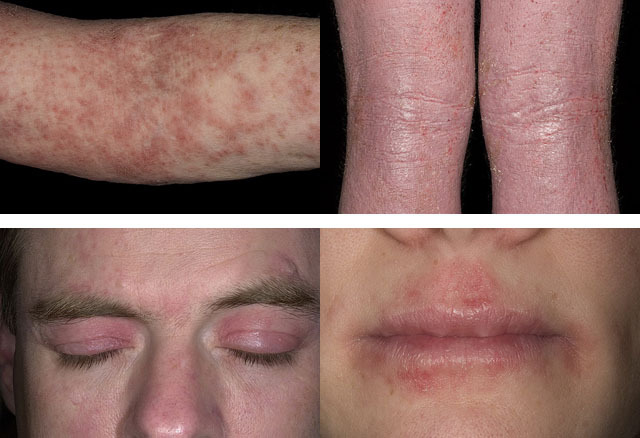 With this form of allergy, the skin, predominantly the flexing surfaces of the limbs, face, neck, hands, feet, fingers, is affected.The skin in these areas blushes, peels off, small pink-red rashes appear.In addition, the skin is very itchy, the person is intensely rubbing it, thereby leaving traces of scratching on it.When bacterial microflora is attached, the wound can become wet with formation of yellowish crusts.Further on the background of atopic dermatitis, allergic dermatitis and bronchial asthma can occur.
With this form of allergy, the skin, predominantly the flexing surfaces of the limbs, face, neck, hands, feet, fingers, is affected.The skin in these areas blushes, peels off, small pink-red rashes appear.In addition, the skin is very itchy, the person is intensely rubbing it, thereby leaving traces of scratching on it.When bacterial microflora is attached, the wound can become wet with formation of yellowish crusts.Further on the background of atopic dermatitis, allergic dermatitis and bronchial asthma can occur.
Diagnostics
We recommend to read:For the diagnosis of allergy to dust, skin, provocative and immunological tests are used.
Skin tests are:
- Scarification:
- Prik tests;
- Application samples.
Scarification tests are carried out as follows: the skin of the flexor surface of the forearm is applied by drop of the allergen.For one manipulation, 10-15 allergens can be applied.Then, through each drop, two parallel scratches are applied by the scarifier.After ten minutes, each drop is gently blotted with separate cotton wool discs.After another ten minutes, assess the skin reaction.If the skin contact with the allergen appears hyperemia, blisters, then the result of allergic tests is positive.
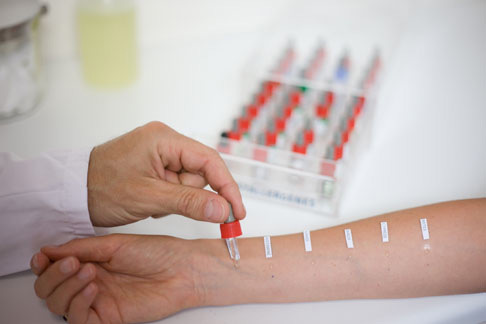
Prik tests are performed with special devices that pierce the skin.Evaluation of the results is also carried out as in the case of scarification tests.
For carrying out application samples, plates with allergens applied to them are attached between the blades and left for two days.The reaction is evaluated after half an hour after removal of the plate, and then every other day.The appearance of hyperemia, papules, vesicles, blisters indicates the presence of allergies.
 Provocative tests are a diagnostic method based on the contact of a susceptible organ with allergens.To identify allergies to home dust, nasal, conjunctival, inhalation tests are performed.When carrying out a nasal provocative test, a drop of control liquid is injected into one nostril in one nostril, and in a sequential one drop of dilution of a dust allergen: 1: 100, 1:10, and then a whole allergen.The test is positive if symptoms of rhinitis appear.With the inhalation test, dust allergens are introduced into the respiratory tract.
Provocative tests are a diagnostic method based on the contact of a susceptible organ with allergens.To identify allergies to home dust, nasal, conjunctival, inhalation tests are performed.When carrying out a nasal provocative test, a drop of control liquid is injected into one nostril in one nostril, and in a sequential one drop of dilution of a dust allergen: 1: 100, 1:10, and then a whole allergen.The test is positive if symptoms of rhinitis appear.With the inhalation test, dust allergens are introduced into the respiratory tract.
Immunological diagnostic methods are based on the detection of antibodies to dust allergens in the blood.The patient is selected venous blood, and then placed on panels containing household allergens( house dust, mite of the genus Dermatophagoides, wool and the epithelium of domestic animals).If you find a high level of antibodies to one of the allergens, you should talk about the presence of an allergy to dust.
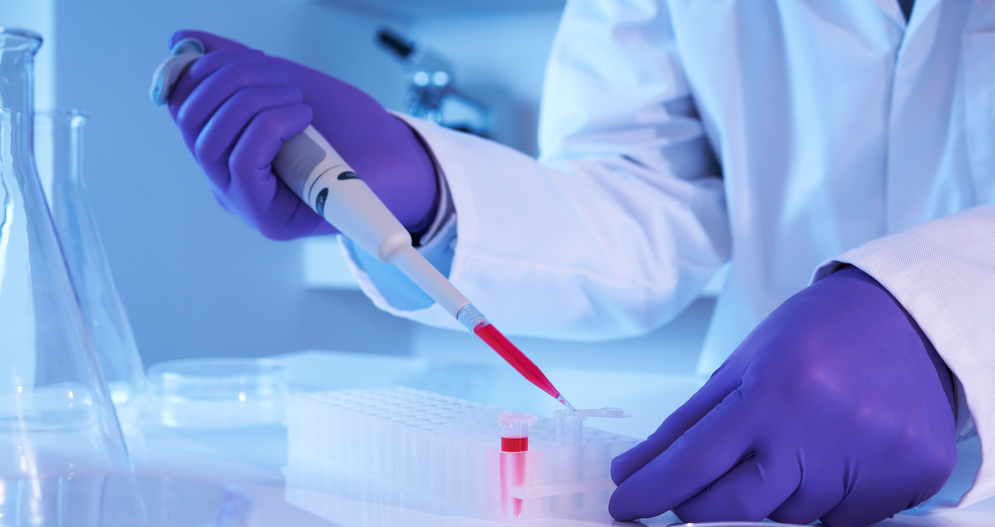
Treatment of dust allergy
Allergy can be treated in several ways: by excluding contact with an allergen, using medicines, undergo a course of specific treatment.
Excluding contact with the allergen
My house is my temple.Here we spend most of our life.And do not want the house to be associated with unpleasant symptoms of the disease.To do this, you need to create a hypoallergenic environment in your home.
First of all, you need to clean the room of unnecessary objects that collect dust: carpets, curtains, decorative fur skins, soft toys.Furniture with fabric upholstery is desirable to replace the leather, and the curtains - blinds.These objects do not themselves accumulate dust, they are easy to wash.
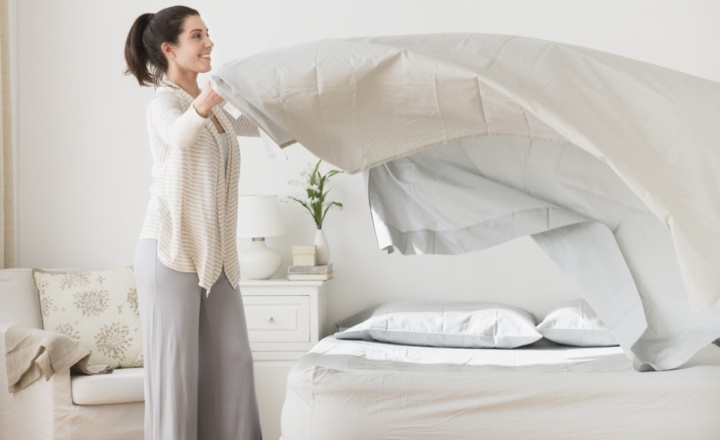 Down and feather pillows, blankets should be replaced with synthetic ones, with good air permeability.It is also important to regularly beat out, air mattresses, blankets and pillows.Bed linen should be washed once or twice a week, you can use special detergents against tick-borne and epidermal allergens.The same substances can handle soft furniture.
Down and feather pillows, blankets should be replaced with synthetic ones, with good air permeability.It is also important to regularly beat out, air mattresses, blankets and pillows.Bed linen should be washed once or twice a week, you can use special detergents against tick-borne and epidermal allergens.The same substances can handle soft furniture.
Particular attention should be paid to cleaning.It is necessary to begin with an elementary: frequent airing of the apartment, and with wet cleanings, the main thing is not to overdo it, the optimum humidity should be up to 50%.Unfortunately, conventional vacuum cleaners can not cope with dust, you need to use vacuum cleaners equipped with special filters.Vacuuming must be very carefully, including cleaning so you can and furniture.It is advisable that cleaning is done by a person who is not allergic, since cleaning one way or another contributes to the movement of dust in the air, which can trigger an increase in allergies.If this is not possible, a person suffering from allergies, doctors recommend using protective masks during cleaning.

You can reduce the dustiness in the room with air purifiers.Air cleaners are devices equipped with filters.Also, a fan is built into the design, which ensures the passage of air through the filters.It is important to clean and change the filters in a timely manner.
Medication Therapy
For medication use drugs that affect the central links of an allergic reaction.These include antihistamines, glucocorticosteroids, membrane stabilizers, antileukotriene agents.
Recommended to read:There are three generations of antihistamines. Currently, most actively used antihistamines of the third generation, such as:
- Cetirizine;
- Fexofenadine( Telfast);
- Desloratadine( Eden);
- Acryvastine( Semprex);
- Astemisole( Histalong);
- Ebastin( Kestin).
Third generation antihistamines do not have the side effects of earlier drugs: drowsiness, toxic effects on the heart, dry mouth.
Glucocorticosteroids( hydrocortisone, prednisolone, dexamethasone) are often used when antihistamines are ineffective.
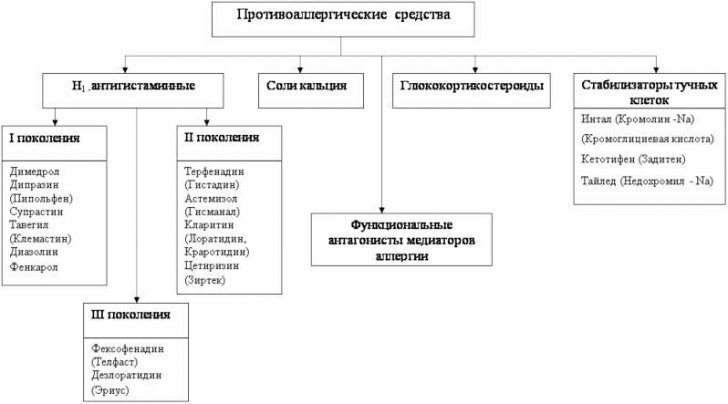
Allergen-specific immunotherapy
This is the only etiopathogenetic treatment method that allows to influence the cause of allergy.The patient is injected with an allergen in gradually increasing concentration, thereby inducing the development of tolerance to the irritant.
By way of introducing an allergen, these types of ASIT are distinguished:
- Subcutaneous;
- Local( sublingual, oral, nasal, bronchial).
Allergen-specific immunotherapy( ASIT) can reduce the severity of allergies, the amount of medication used, and significantly improve the quality of life.
Grigorova Valeriya, medical reviewer



